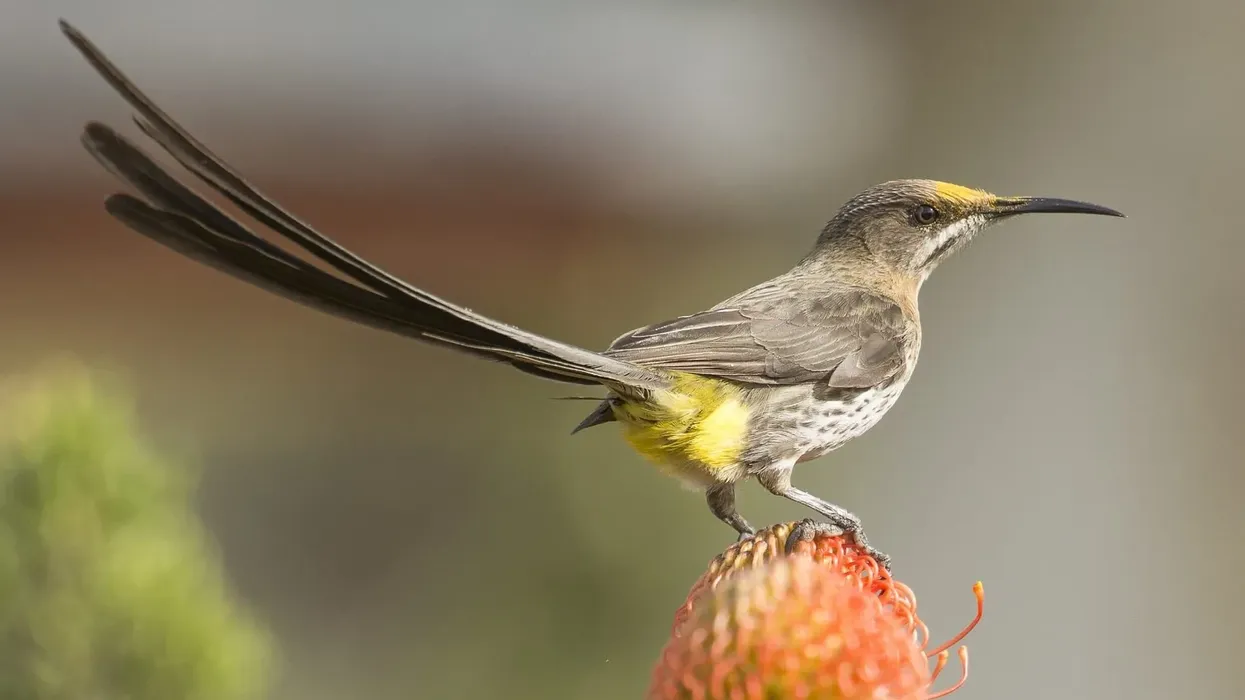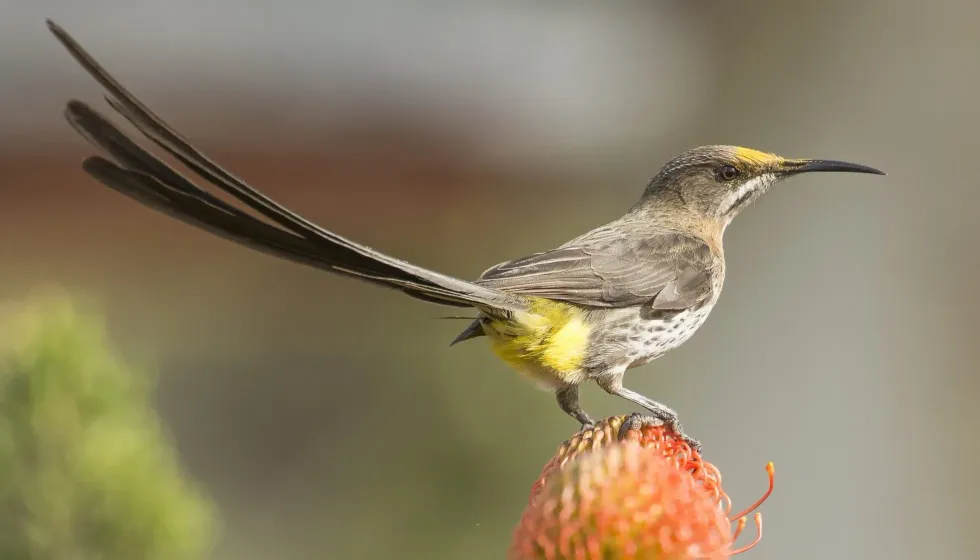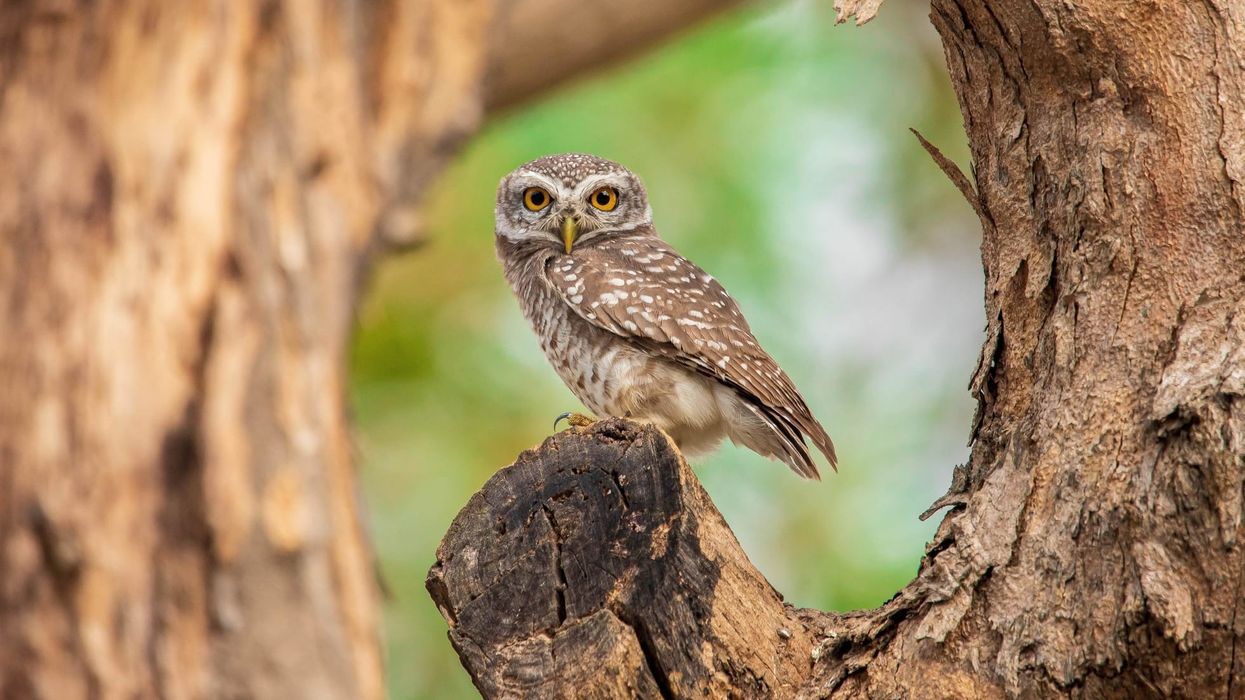Sugarbirds of the genus Promerops are part of the family of Promeropidae of passerine birds endemic to Southern Africa. These birds have two species associated with them.
The Cape sugarbird (Promerops cafer) and the gurney's sugarbird (Promerops gurneyi), are both found exclusively in Southern Africa. The Cape Sugarbird is found in the Fynbos biome of South Africa.
Both the species, although similar in some features, have prominent differentiation in the microsatellite and mitochondrial loci with wide distribution.
They show no sign of inbreeding and are found on opposite sides of the range of their habitat. At first, sugarbirds were considered a part of the honeyeater family which is endemic to Australia, but later they were put under the new family.
The Cape sugarbird nests in dense vegetation and high elevated areas. Vegetations of Proteas are necessary for the Cape sugarbird as they feed on the nectar of the plants and the insects that the nectar attracts are caught and fed to the chicks.
The gurney's sugarbird too is dependent on the sugarbush species (another name for the flowering plant from South Africa - Protea) and also consumes many different species of insect as their regular food.
Find out some interesting facts about robins and the bearded vultures only on the Kidadl website.
Sugarbird Interesting Facts
What type of animal is a sugarbird?
The Cape sugarbird (Promerops cafer) and the gurney's sugarbird are species of passerine birds endemic to the Southern part of the African continent.
What class of animal does a sugarbird belong to?
Sugarbirds are part of the family of Promeropidae in the class of Aves of the Animalia kingdom.
They are closely related to the Honeyeaters of the family Meliphagidae from Australia.
How many sugarbirds are there in the world?
The population of the Cape sugarbird is not known, but this species is said to occur commonly on the African continent. Their range is also extensive.
The population of the gurney's sugarbird is said to be decreasing in an alarming manner in recent years. The exact numbers are not known.
Where does a sugarbird live?
The distribution of the sugarbirds has a very limited range in the Southern part of the African continent. The Cape sugarbird is found in the Fynbos of South Africa.
This is the dominant vegetation area of the Cape Floral Region of South Africa, located at the southernmost tip of the country. The Cape sugarbird is commonly found in the botanical gardens in the Western Cape province of South Africa.
Gurney's sugarbird is only found in Southern Africa. Some populations of this bird are found in the highlands of Eastern Zimbabwe and Mozambique.
What is a sugarbird's habitat?
Both the Cape sugarbird (Promerops cafer) and the gurney's sugarbird (Promerops gurneyi) are dependent on Protea and are mostly found in Protea scrub.
Fynbos is a belt of natural shrubland vegetation in the Western and Eastern Cape provinces in South Africa. This region called Fynbos has a Mediterranean climate and a rainy winter season. The Cape sugarbird is found mostly in the Fynbos.
Cape sugarbirds have also been found in gardens and nurseries. Gardens do not usually have Protea, but the birds have evolved to live within urban civilizations. The Cape sugarbird is found in the region which is almost free from recently burnt areas.
The gurney's sugarbird is found in shrubland velds of Southern Africa which are dominated by Protea species of flowering plants. They are related to a habitat with only protea shrubs, therefore, these gurney's sugarbird is very vulnerable to habitat loss and fire in the protea shrubs.
Who do sugarbirds live with?
They form pairs for a lifetime in most cases during the breeding season. They usually are found in pairs or groups and are solitary nesters.
How long does a sugarbird live?
The average lifespan of the sugarbirds is seven years.
How do they reproduce?
Sugarbirds are monogamous. Sometimes they are found changing partners, but the bird only mates with one partner in a season. Males perform vocal displays to attract the female.
In the case of the Cape sugarbird, the breeding season is from April to May in the south-western Cape province. In South Africa, the breeding is done in winter from February to August.
The female makes the nest with stems, grasses, and dry leaves from protea flowers. The female lays 1-2 eggs in a season and incubates alone for 12-20 days. The males protect the nest from other birds and predators.
The chicks become independent in three weeks. Until then, feeding is carried out by both the adult male and female.
The gurney's sugarbird's breeding season starts in September and ends in February. Their season ends before the Cape sugarbird starts its breeding in April. They leave the breeding grounds once the flowering season is finished.
What is their conservation status?
The Cape sugarbird is categorized as of Least Concern by the IUCN Red List as the bird is found commonly in South Africa.
However, gurney's sugarbird is considered near threatened by the IUCN Red List. This is because the habitat of the bird is limited only to protea shrub. Frequent fires and habitat degradation has led to the reduced numbers of gurney's sugarbird.
Sugarbird Fun Facts
What do sugarbirds look like?

Both the species of the bird are medium-sized and have a long tail. The tail in the Cape sugarbird is longer than the gurney's sugarbird. The males have a longer tail and a larger body than the females.
The Cape sugarbird is colored grey-brown and has a yellow spot under its prominently elongated tails. The long tail is present in the gurney's sugarbird too.
The bird has a dull brown body above and pale coloration below with a spot of yellow under the tail. They have a rusty breast and brown which is not present in the Cape sugarbird. The cape sugarbird from South Africa also has a bigger body and a much longer graduated tail.
Both species have a long and thin bill, which is slightly curved. The tongue is long, tubular, and frilled at the tip.
The long-tailed body of the sugarbird links them with a lot of hummingbirds, but they are not a part of that family.
Sugarbirds resemble the long-tailed sunbirds, family Nectariniidae, of passerine birds.
How cute are they?
These birds are very beautiful with their smaller body, long tails, and curved bills.
How do they communicate?
Sugarbirds are known to communicate with different types of voices. They also communicate by flapping their wings. This sound is made to attract females during the breeding season.
How big is a sugarbird?
The length of the sugarbirds ranges from 9.1–17.3 in (23-44 cm).
How fast can a sugarbird fly?
The speed of sugarbirds is not known.
How much does a sugarbird weigh?
The weight ranges from 0.06-0.1 lb (26-46 g).
What are the male and female names of the species?
The male and female sexes are not given separate names. They are known by their scientific names, The Cape sugarbird (Promerops cafer) and the gurney's sugarbird (Promerops gurneyi).
What would you call a baby sugarbird?
The babies are called chicks.
What do they eat?
The prime source of food for the sugarbirds is nectar from Proteas. The long, sharp beak helps them to reach the nectar easily. They also feed on spiders and insects.
They also feed on different insects including aphids, grasshoppers, beetles, and flies. The chicks are fed the small insects by the parents before they start feeding on the proteas.
The enemies of the Cape sugarbird endemic to Southern Africa are ravens, shrikes, mongooses, rodents, and snakes.
Are they poisonous?
The sugarbirds are not poisonous.
Would they make a good pet?
These birds need their own habitat to thrive and stay alive. The habitat with Protea shrub is the most important criteria for these birds.
Did you know...
Sugarbirds are not considered hummingbirds.
Sugarbird Cape Fynbos Gin is a handcrafted gin from South Africa known for its unique taste profile and named primarily for the African sugarbirds.
Do sugarbirds migrate?
They usually do not migrate, but the Cape sugarbird can migrate across the city when areas of the Peninsula are burnt by fire.
Where does the sugarbird build its nest?
The nest of the sugarbirds is shaped like a cup and made of twigs, grasses, and pine needles and lined with protea. Their nest is built in the foliage of a bush, often among Protea trees.
Here at Kidadl, we have carefully created lots of interesting family-friendly animal facts for everyone to discover! Learn more about some other birds including crane facts and falcon facts.
You can even occupy yourself at home by coloring in one of our free printable sugarbird coloring pages.








